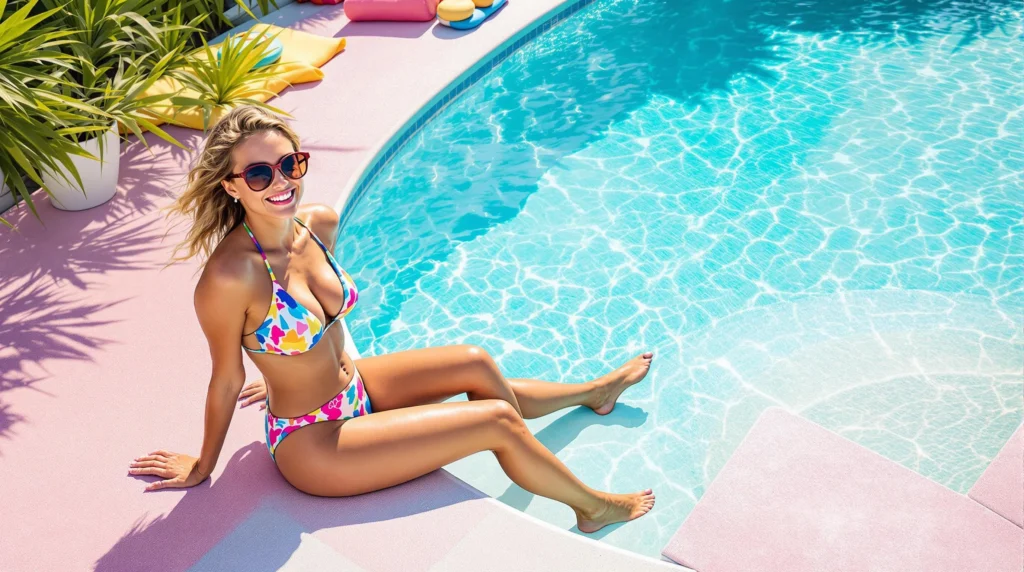Looking to refresh your pool area? Choosing the right paint for the concrete surrounding your pool isn’t just about aesthetics—it’s essential for safety and longevity. With so many options available, finding the perfect pool deck coating can feel overwhelming.
We’ve researched and tested many concrete paints designed specifically for pool surroundings to help you make an well-informed choice. The ideal pool deck paint should resist slipping when wet, withstand harsh UV rays, repel chemicals, and maintain its appearance even though constant exposure to water. In this guide, we’ll reveal our top picks that deliver outstanding performance while keeping your pool area looking pristine for years to come.
Why Choosing the Right Pool Deck Paint Matters
The paint you select for your concrete pool deck does far more than just enhance its visual appeal. Quality pool deck coatings create a protective barrier that shields your concrete from constant exposure to water, chemicals, and UV rays. Without proper protection, your pool deck can quickly deteriorate, developing cracks, pitting, and discoloration that compromise both safety and aesthetics.
Safety becomes a primary concern when considering pool deck surfaces. Standard paints often become dangerously slippery when wet, creating hazardous conditions for everyone enjoying your pool area. Specialized pool deck paints incorporate anti-slip additives that maintain traction even when the surface is soaking wet, preventing potential falls and injuries.
Durability factors heavily into the equation when selecting the right coating. Pool decks endure extreme conditions, from scorching summer heat to freezing temperatures in certain regions. They’re also subjected to pool chemicals, salt (for saltwater pools), and constant foot traffic. Inferior paints will peel, chip, and fade within months, requiring frequent reapplication and increasing your long-term costs.
Maintenance requirements vary significantly between different paint types. Some coatings demand regular stripping and reapplication, while high-quality epoxy or acrylic products can last for years with minimal upkeep. We’ve found that investing in premium pool deck paint initially often results in substantial savings over time due to reduced maintenance needs.
Environmental considerations should influence your paint selection process as well. Many modern pool deck coatings offer eco-friendly formulations that minimize harmful VOCs (Volatile Organic Compounds) while still delivering excellent performance. These environmentally conscious options protect both your family and the network without sacrificing quality or longevity.
7 Best Paints for Concrete Around Pools
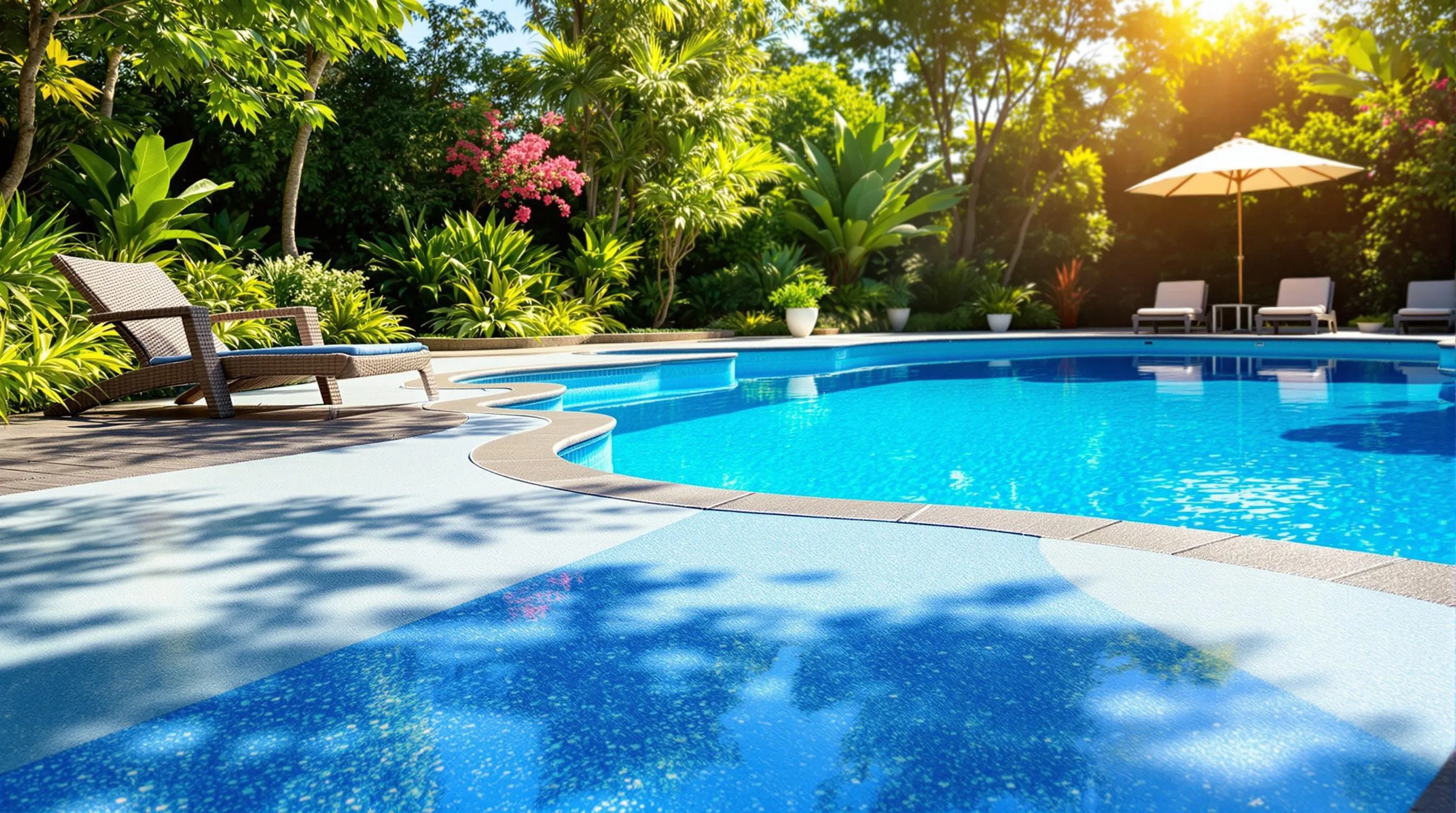
After extensive research and testing, we’ve identified the top protective coatings that deliver superior performance for pool deck surfaces. Each option offers unique benefits to address exact needs around your pool area.
Epoxy Pool Deck Coatings
Epoxy coatings stand out as the most durable option for concrete pool decks, offering exceptional resistance to chemicals, UV rays, and heavy foot traffic. These industrial-strength formulations create a hard, protective shell that prevents water penetration and extends the life of your concrete surface. Professional application is typically recommended for epoxy, as the mixing and curing process requires precise timing and technique to achieve optimal results. The impressive longevity of properly applied epoxy coatings makes them cost-effective even though their higher initial investment.
Acrylic Pool Deck Paint
COOL! by Encore Coatings leads the acrylic category with its remarkable heat-reducing properties, reflecting sunlight to keep surfaces up to 38% cooler than untreated concrete. This DIY-friendly option offers unlimited color choices while providing excellent slip resistance through its textured finish. Acrylic paints bond well with most concrete surfaces and resist fading in sunny environments. One limitation to note is incompatibility with existing cool deck coatings, requiring removal of old surfaces before application. Maintenance is straightforward with periodic cleaning, making acrylics a practical choice for homeowners seeking balance between performance and ease of use.
Rubber-Based Pool Deck Paint
Rubber-based formulations provide superior flexibility and comfort underfoot, creating a slightly cushioned surface that’s particularly gentle on bare feet. These coatings excel in slip resistance, maintaining traction even when wet, which significantly enhances pool deck safety. Elasticity allows rubber coatings to expand and contract with temperature fluctuations without cracking. UV exposure can accelerate degradation of some rubber-based products compared to epoxy or polyurethane alternatives, potentially requiring more frequent reapplication in areas with intense sunlight.
Polyurethane Pool Deck Sealers
Polyurethane sealers deliver a high-gloss, attractive finish while providing robust protection against chemicals, abrasion, and color fading. Their exceptional resistance to chlorine and pool chemicals makes them particularly suitable for areas closest to the pool edge. Application requires thorough surface preparation and often multiple coats for maximum effectiveness. Though less commonly used than epoxy or acrylic options, polyurethane offers comparable durability with a more aesthetic appearance, making it ideal for homeowners who prioritize both protection and visual appeal.
Anti-Slip Textured Concrete Paints
Safety-focused textured paints incorporate additives like rubber particles or silica sand to create grip-improving surfaces essential for wet pool environments. These specialized formulations significantly reduce slip-and-fall accidents while maintaining an attractive appearance. Products like COOL! already include texture by default, eliminating the need for separate additives. Application techniques can adjust the degree of texture based on exact needs and foot traffic patterns. Regular cleaning prevents buildup that might diminish the non-slip properties over time.
Water-Based Pool Deck Stains
Penetrating concrete stains offer a natural, translucent color effect that enhances rather than conceals the concrete’s character. Unlike surface coatings, quality stains bond with the concrete at a molecular level, preventing the peeling issues common with traditional paints. These formulations allow concrete to breathe naturally while providing subtle color enhancement. Water-based options provide environmentally friendly application with minimal odor and VOCs. Combining stains with a compatible clear sealer creates the ideal balance of aesthetic appeal and practical protection.
Clear Concrete Sealers with UV Protection
Clear sealers preserve the existing look of concrete while providing invisible protection against water damage, staining, and ultraviolet deterioration. These versatile products work exceptionally well over decorative concrete or surfaces with attractive natural coloration. Reapplication every 1-3 years maintains optimal protection levels, though high-quality versions can last longer in moderate climates. Many professionals recommend pairing clear sealers with concrete stains for enhanced durability without sacrificing the natural appearance. UV inhibitors in modern formulations prevent the yellowing effect that plagued earlier generations of clear sealers.
Key Features to Look for in Pool Deck Paint
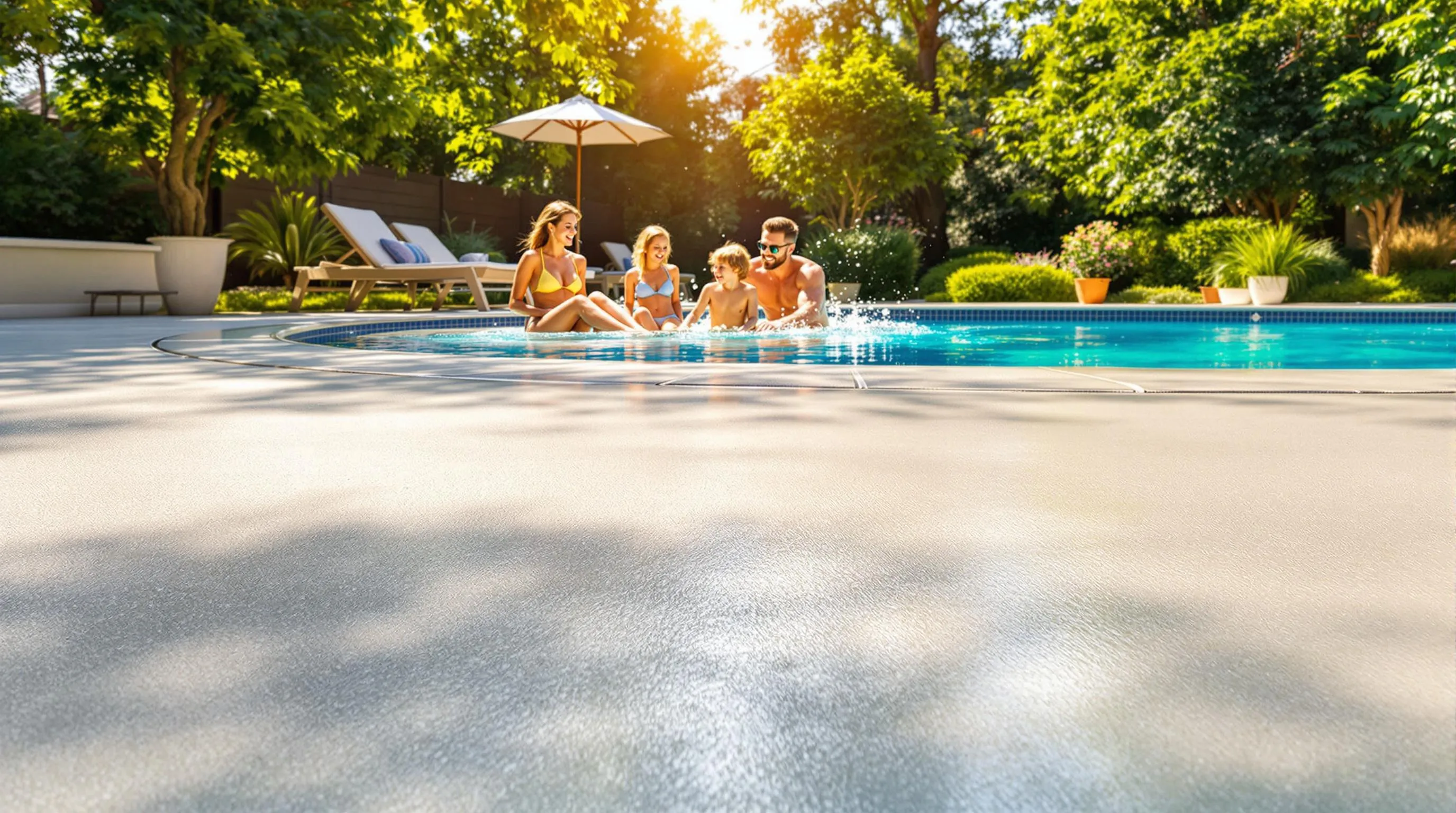
When selecting the ideal paint for your pool deck, certain features distinguish superior products from mediocre ones. We’ve identified the critical characteristics that ensure your pool deck remains safe, comfortable, and visually appealing for years to come.
Heat Reflection Properties
Heat reflection capabilities significantly impact comfort around your pool area during hot summer days. Encore Cool Pool Deck Coating reduces surface temperatures by up to 38% through advanced solar reflectance technology, keeping your deck comfortable even in direct sunlight. Light-colored formulations maximize this cooling effect, allowing you to walk barefoot without discomfort. Darker tints, while aesthetically pleasing, diminish heat reflection effectiveness and should be avoided in extremely hot climates. For optimal thermal performance, we recommend pairing specialized cooling coatings with light-colored paint options to create the most comfortable poolside environment.
Slip Resistance Ratings
Safety should be your primary concern when selecting pool deck paint, particularly about slip resistance. Quality coatings provide a uniform, textured surface that prevents dangerous falls while maintaining an attractive appearance. Unlike traditional rough-textured surfaces that trap dirt and debris in countless crevices, modern answers like Encore’s products offer non-slip finishes that remain easy to clean. Epoxy-based paints enhance traction when properly mixed with specialized additives, creating a safer surface around your pool. The ideal pool deck coating strikes the perfect balance between sufficient grip for wet conditions and a surface that doesn’t abrade bare feet.
UV and Chemical Resistance
Pool decks endure constant exposure to harsh sunlight and chemicals, making UV and chemical resistance essential qualities in your chosen paint. UV-resistant formulations prevent premature fading and degradation that can make your deck look worn and neglected. Encore’s coating works effectively with Nano-Acrylic Sealers to provide enhanced protection against chlorine, sunscreen oils, and other pool chemicals that typically damage standard paints. Polyurea coatings offer superior fade resistance under prolonged sun exposure, maintaining their color integrity season after season. Your pool deck paint must form a protective barrier against both ultraviolet radiation and the harsh chemicals used in pool maintenance.
Durability and Longevity
Investing in durable pool deck paint saves you time and money by extending the periods between reapplications. Encore Cool Coating not only repairs existing cracks but also resurfaces concrete entirely, lasting significantly longer than standard paint when properly sealed. Epoxy paints deliver excellent durability but require thorough surface preparation and exact additives to maintain flexibility in outdoor conditions. Polyurea coatings stand out for their exceptional resistance to thermal expansion and contraction, making them less prone to cracking compared to acrylic alternatives. Cement-based options like skim coats (sand/cement mixtures) offer a longer-lasting alternative to traditional paint, though they typically require professional application for best results. Products specifically designed for pool decks that prioritize UV protection, slip resistance, and compatibility with quality sealers will provide the longest service life in challenging pool environments.
How to Properly Prepare Your Pool Deck for Painting
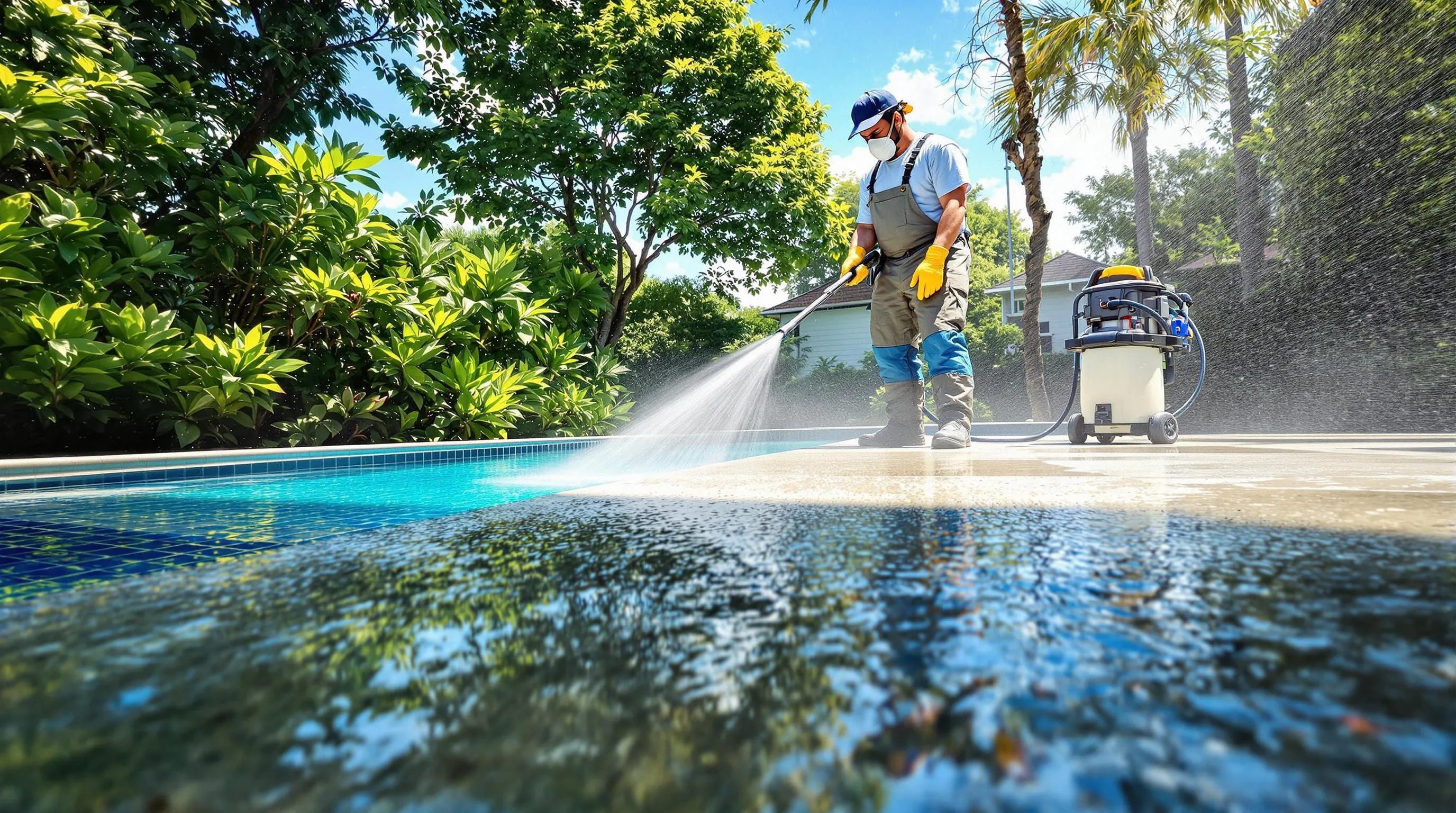
Preparing your concrete pool deck properly before painting is crucial for ensuring long-lasting results. Without adequate preparation, even the highest quality paint can fail prematurely. We’ve outlined the essential steps to get your pool deck ready for a beautiful, durable finish.
1. Clean Thoroughly
A thorough cleaning removes all contaminants that could prevent proper paint adhesion. Start by sweeping away loose debris, then use a pressure washer or specialized degreaser to eliminate dirt, algae, and any existing coating residue. For stubborn stains, a concrete-exact cleaner will help break down oils and organic matter that regular cleaning might miss.
2. Repair Cracks
Addressing structural issues before painting prevents future problems. Carefully inspect your deck for cracks, chips, or uneven areas, then fill them with a quality concrete patching compound. Allow the repairs to cure completely according to the manufacturer’s instructions before proceeding to the next step. This attention to detail creates a smooth, uniform surface for paint application.
3. Etch Surface
Surface etching improves paint adhesion by creating a slightly roughened texture. Apply a concrete etcher or acid wash following the product instructions, typically by spreading the solution evenly across the surface and allowing it to work for the recommended time. After etching, thoroughly rinse the surface with clean water and allow it to dry completely.
4. Prime (If Needed)
Some pool deck coatings require a primer for optimal performance. Check your selected paint’s requirements—many modern acrylic coatings like Encore Cool adhere directly to properly prepared surfaces without primer. If priming is necessary, select a product specifically designed for exterior concrete and pool environments.
5. Apply Paint
The final step involves applying your chosen pool deck paint under optimal conditions. Use a roller or sprayer for even coverage, working in sections to maintain a wet edge. Temperature conditions significantly impact results—aim for application when temperatures are between 50–90°F with low humidity. Avoid painting in direct sunlight or when rain is expected within 24 hours.
For maximum protection, consider applying Encore’s SealBack Nano-Acrylic Sealer as a final protective layer over your paint. This additional step enhances durability against pool chemicals and UV exposure, potentially extending the life of your pool deck coating by several years.
Step-by-Step Guide to Applying Concrete Pool Deck Paint
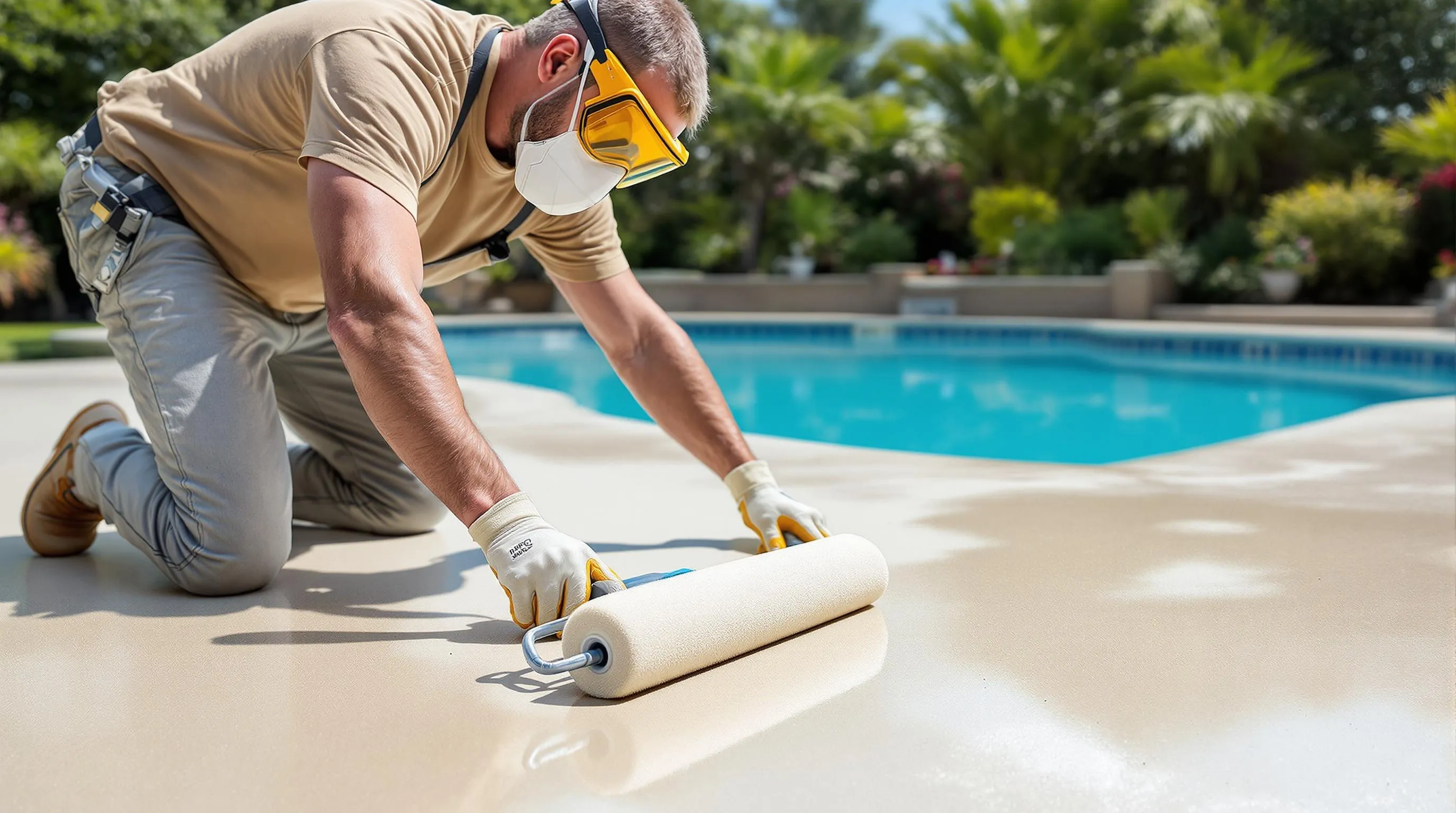
1. Surface Preparation
Surface preparation is the most critical step for ensuring your pool deck coating will last. Start by thoroughly pressure washing the concrete to remove all debris, oils, and previous coatings that might interfere with adhesion. Any old, flaking paint must be completely stripped away before proceeding. Repair all cracks and damaged areas using a quality concrete patching compound, allowing sufficient time for repairs to cure properly.
2. Priming the Surface
Applying a concrete bonding primer creates the ideal foundation for your pool deck paint to adhere properly. Check your exact product’s instructions, as some premium coatings like Encore Cool are formulated to be primer-free, saving you time and effort. When using primer, apply it evenly with a roller, working in sections to maintain a wet edge throughout the application process.
3. Mixing the Coating
Proper mixing ensures consistent color and performance across your entire pool deck. Stir the paint thoroughly before application, using a drill with a mixing attachment for best results. For epoxy-based products, carefully combine the resin and hardener according to the manufacturer’s exact ratios to achieve proper curing and maximum durability.
4. Application Techniques
Apply your chosen coating using a quality roller with an extension handle for larger areas and a brush for cutting in around edges and tight spaces. Work in manageable sections, applying thin, even coats to prevent pooling or uneven drying. Multiple thin coats will provide better results than one thick application, so don’t rush this process.
5. Adding Slip Resistance
Safety around wet pool decks requires proper slip resistance. Broadcast anti-slip granules onto the wet coating if your selected product doesn’t already include this feature. Products like Encore Cool and Valspar Pool Deck & Walkway have built-in slip-resistant properties, eliminating this extra step while still providing crucial safety benefits.
6. Drying Time
Allow sufficient drying time between coats, typically 24-48 hours depending on temperature and humidity levels. Avoid foot traffic for at least 24 hours after the final coat application. Complete curing may take several days, so plan your project accordingly, especially if you’re preparing for pool season or expecting guests.
7. Sealing for Protection
Finish your pool deck project by applying a quality sealer like Encore’s SealBack nano-acrylic sealer for enhanced stain resistance and longevity. This final protective layer shields your newly coated deck from pool chemicals, UV damage, and general wear, significantly extending the life of your investment and maintaining its appearance for years to come.
Maintenance Tips for Painted Pool Decks

Maintaining your painted pool deck properly extends its lifespan and keeps it looking fresh year after year. Regular upkeep prevents costly repairs and ensures your pool area remains safe for everyone to enjoy. Here are essential maintenance practices to follow:
Allow Proper Curing Time
Newly painted pool decks require at least 24 hours of curing time before any water exposure. During this critical period, avoid all foot traffic on the surface to allow the paint to bond properly with the concrete. Patience during this initial phase directly impacts how well your coating performs in the long run.
Use Gentle Cleaning Methods
Clean your pool deck regularly with mild soap and water to prevent dirt buildup. We recommend avoiding harsh chemicals or abrasive scrubbing tools that can damage the protective coating. A soft-bristled brush or mop works perfectly for routine cleaning without compromising the paint’s integrity.
Apply Annual Sealer
Enhance your deck’s longevity by applying a nano-acrylic sealer like Encore’s SealBack once a year. This protective layer significantly improves stain resistance and extends the life of your coating. Annual sealing creates an additional barrier against the harsh elements your pool deck faces daily.
Address Damage Promptly
Repair any cracks or chips as soon as you notice them to prevent further deterioration. Use compatible patching compounds that work with your exact coating type before repainting affected areas. Quick action on minor damage prevents more extensive repairs later.
Protect Against Pool Chemicals
Immediately rinse off any chlorine, salt, or other pool chemicals that splash onto your deck using a garden hose. Chemical exposure can gradually degrade even the most durable coatings like Valspar Pool Deck & Walkway, which offers excellent chemical resistance but still benefits from prompt rinsing.
Monitor Slip Resistance
Test the slip resistance of your deck surface regularly, especially after it gets wet. Products like Encore Cool Pool Deck Coating offer built-in slip resistance, but this property can diminish over time. Add traction-improving additives during recoating if you notice the surface becoming slippery when wet.
Schedule Periodic Inspections
Conduct thorough inspections of your pool deck at least twice a year to catch potential issues early. Look for signs of fading, peeling, or cracking that might indicate it’s time for a touch-up or recoating. Preventive maintenance helps avoid complete restoration projects that are both time-consuming and expensive.
Common Mistakes to Avoid When Painting Pool Concrete
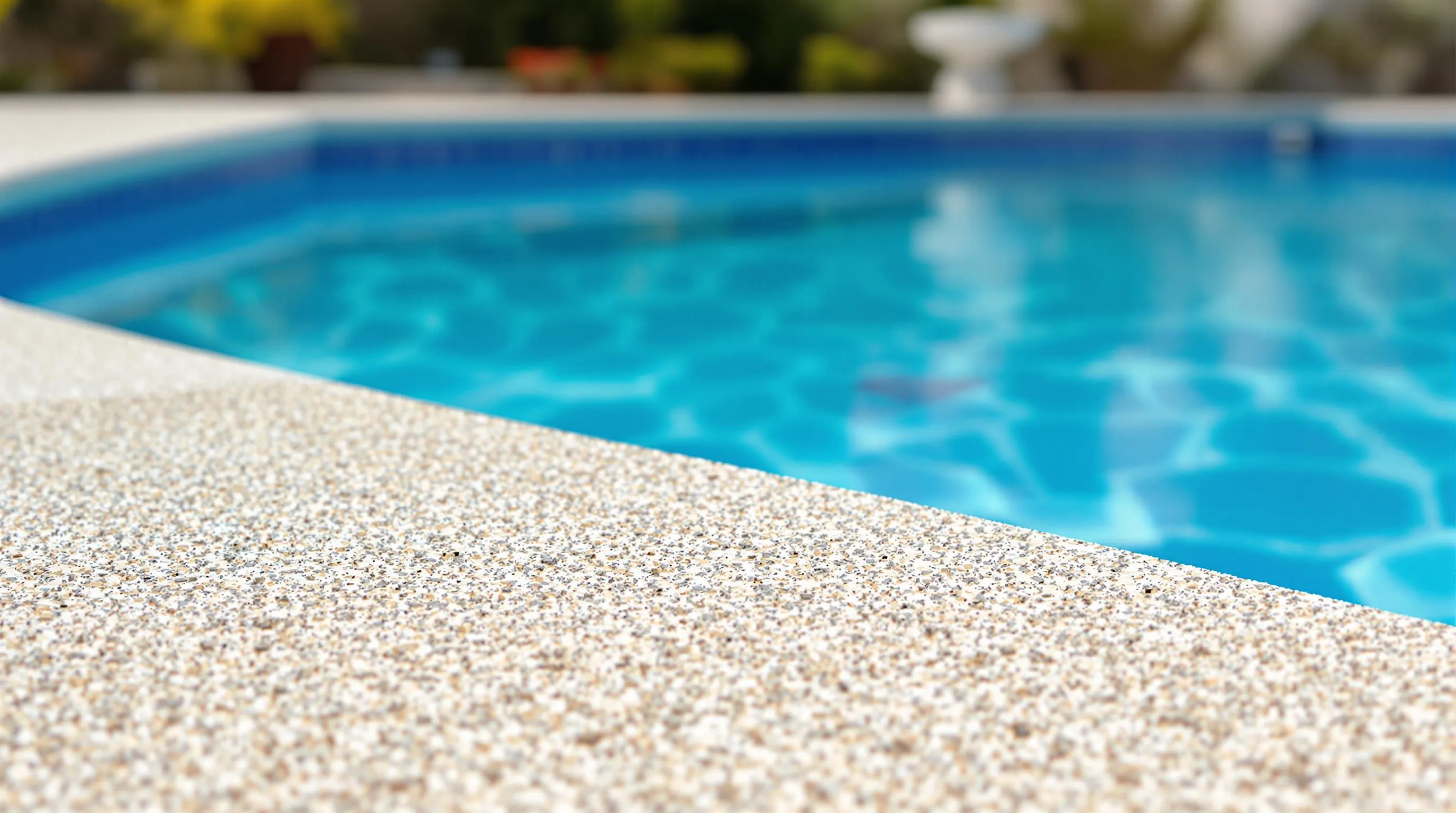
Even with the best intentions, many pool owners make critical errors when painting their concrete pool decks. Recognizing these common pitfalls can save you time, money, and frustration while ensuring your pool area remains safe and attractive for years to come.
Using Traditional House Paint
Traditional house paint is completely unsuitable for pool environments even though its lower cost and availability. These standard paints aren’t formulated to withstand constant moisture, chlorine exposure, or intense UV radiation that pool areas experience daily. Without proper chemical resistance, house paint quickly deteriorates when exposed to pool chemicals, leading to peeling, bubbling, and potential safety hazards. The lack of slip-resistant properties in regular paint also creates dangerous conditions when the deck becomes wet from splashing or rain.
Inadequate Surface Preparation
Skipping thorough preparation work virtually guarantees paint failure regardless of how premium your coating might be. Many homeowners rush this critical step, failing to properly clean, repair, and etch the concrete surface before application. Concrete must be completely free of dirt, oils, and previous coatings to allow proper adhesion. Simply applying new paint over old, deteriorating coatings will result in premature failure and wasted investment, as the new coating won’t have a stable surface to bond with.
Ignoring Weather Conditions During Application
Applying pool deck paint during inappropriate weather conditions dramatically affects its performance and longevity. Extreme temperatures, high humidity, or impending rain can prevent proper curing and adhesion. Paint applied in direct sunlight often dries too quickly, preventing proper penetration and bonding with the concrete substrate. Moisture trapped beneath hastily applied paint will eventually force the coating to separate from the surface, creating unsightly bubbles and peeling sections.
Overlooking Slip Resistance
Pool decks become exceptionally hazardous when wet, yet many homeowners select paints based solely on appearance without considering safety factors. Products designed specifically for pool areas, like Encore’s COOL Pool Deck Paint, incorporate non-slip textures that maintain traction even when wet. Failing to choose paint with adequate slip resistance puts family members and guests at risk of dangerous falls and potential injuries. This safety feature remains essential for any pool deck coating, regardless of its other attributes.
Painting Over Old Coatings Without Testing Compatibility
Applying new paint directly over existing coatings without testing compatibility often leads to adhesion problems and premature failure. Different paint formulations may react negatively with one another, causing bubbling, peeling, or discoloration. Supreme Paints & Coatings epoxy products can be applied over existing coatings, but most paints require removal of previous finishes for optimal performance. This common shortcut significantly reduces both the appearance and lifespan of your pool deck coating while diminishing important properties like heat resistance.
Conclusion: Selecting the Best Paint for Your Pool Deck
Choosing the right paint for your concrete pool deck is a crucial investment in both safety and aesthetics. We’ve shown that specialty coatings like epoxy acrylic and rubber-based formulations offer superior protection against the harsh pool environment while providing essential slip resistance.
Remember that proper preparation and application techniques are just as important as the product you select. Taking time to thoroughly clean repair and prime your surface will dramatically extend the life of your coating.
For optimal results we recommend products with heat-reflective properties UV resistance and chemical protection. Brands like Encore COOL! coating stand out for their comprehensive benefits.
By following our guidelines for selection application and maintenance you’ll create a beautiful durable pool deck that enhances your outdoor space for years to come.
Frequently Asked Questions
What type of paint is best for pool decks?
Epoxy coatings offer exceptional durability and resistance to chemicals and UV rays, making them cost-effective despite higher initial costs. Acrylic paints like COOL! by Encore Coatings reduce heat and provide slip resistance. Other excellent options include rubber-based paints for flexibility, polyurethane sealers for aesthetics, anti-slip textured paints for safety, water-based stains for natural looks, and clear concrete sealers for protection.
How important is slip resistance in pool deck paint?
Slip resistance is crucial for pool deck paint as it directly impacts safety. Standard paints can become dangerously slippery when wet, potentially causing falls and injuries. Modern pool deck coatings contain anti-slip additives that provide textured surfaces while remaining easy to clean. When selecting paint, always check slip resistance ratings and consider adding additional anti-slip granules during application if needed.
How do I prepare my pool deck before painting?
Proper preparation includes thorough cleaning with pressure washing to remove contaminants, repairing all cracks and damages, etching the concrete to improve paint adhesion, and applying a primer if required by your chosen paint system. Ensure the surface is completely dry before beginning. These preparation steps are critical for achieving long-lasting results and preventing premature paint failure.
Can I paint over existing pool deck coating?
You should avoid painting over old coatings without testing compatibility first. Incompatible products can cause adhesion problems and premature failure. In most cases, removing the old coating completely is recommended. Products like Encore’s COOL! coating specifically require removal of previous surfaces before application. When in doubt, consult with a coating specialist about proper removal techniques.
How long will pool deck paint last?
The lifespan of pool deck paint varies by product type and quality. High-quality epoxy or acrylic products typically last 3-7 years before requiring reapplication. Polyurea coatings may last even longer. Factors affecting longevity include climate conditions, foot traffic volume, maintenance practices, and exposure to pool chemicals. Regular maintenance and annual sealer application can significantly extend the life of your deck coating.
What maintenance does a painted pool deck require?
Maintain your painted pool deck by allowing proper curing time after application, cleaning regularly with mild soap and water (avoiding harsh chemicals), applying an annual sealer like Encore’s SealBack, promptly repairing any damages, protecting against chemical spills, and monitoring slip resistance. Schedule periodic inspections to catch potential issues early. Proper maintenance significantly extends the coating’s lifespan.
Does pool deck paint reduce heat?
Yes, certain pool deck paints significantly reduce surface temperatures. Light-colored formulations reflect solar radiation rather than absorbing it, creating a cooler walking surface. Products specifically designed for heat reduction, like Encore’s COOL! coating, can lower surface temperatures by up to 40°F compared to traditional concrete. This heat-reflective property enhances comfort for barefoot walking during hot summer days.
Why is regular concrete paint not suitable for pool decks?
Regular house paint lacks the specialized properties needed for pool environments. It doesn’t resist pool chemicals, UV exposure, or constant moisture, leading to quick deterioration. Standard paints become dangerously slippery when wet and don’t withstand heavy foot traffic. They typically peel, crack, and fade rapidly around pools, requiring frequent reapplication and potentially creating unsafe conditions.

